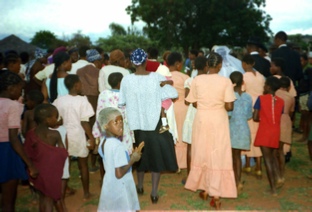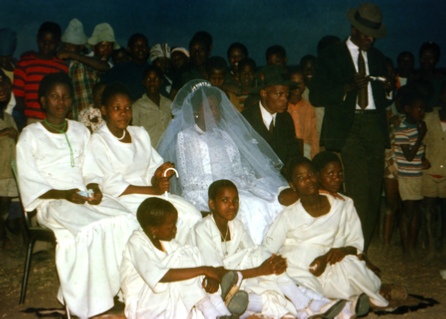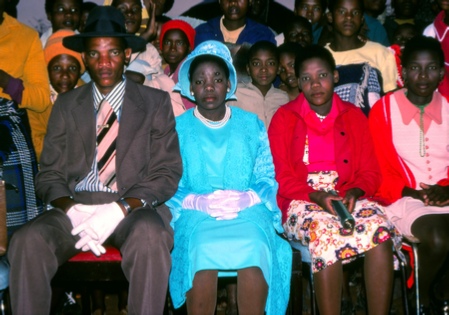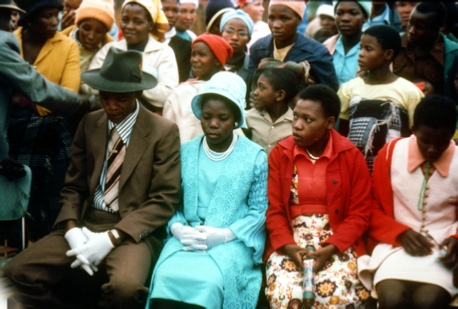© 2018 Dr Margaret Sheppard
Departure of groom
After sunset (probably between 7 -
Such a choir usually sings:
"Knock: Knock: We are arriving with a bride(groom “) The Setswana words are: "Coco, Co, Re tsena go. Ditlo, Ditlo."
As cars carrying the wedding party arrive at the groom's Kgotla they usually drive all round the Kgotla hooting loudly.
Wedding at Groom’s Home
The next part of this type of marriage take place at the groom's home. As has already been stated this may take place the next day or the next weekend. The bride is usually taken at about 11.00-
Then the next day at about midday, married relatives of the bride collect at the bride's home to take her in procession with her possessions to her husband's house. This is done in the same way as with the traditional Setswana wedding. She dresses in ordinary smart clothes and wears a head scarf and a blanket, and carries a lamp or a broom.
All the remaining parts of the marriage are the same as the Setswana Wedding. The bride is given the laws of marriage and shown her house in the same way. Various relatives on both sides make the traditional presents in the traditional way of traditional beer at the respective homes
Appearance of the Bridal Couple
Wile the bridal coupe are eating and the rest of the guests share in the wedding feast, the wedding choirs are singing and dancing in turn outside the lolwapa of the wedding house. Neighbours, friends and passers-
During the latter part of the afternoon, towards sunset, the bridal couple are brought out to see their choirs. They are led out of the house by some of the female relatives who sing the following song :-
"Ula-
Usually a female relative leads and as she sings she claps her hands in time to the rhythm of the song. The bridal couple follow immediately behind and then the bridesmaids and other attendants. The couple are sheltered by their umbrellas which are held over them if the sun has not yet set.
They are led to the side of where the choirs are singing, and sit on chairs and skin mats that have been placed for them. The bride's dress is again arranged for her by her chief bridesmaids, and the groom is "dusted off" by the best man with the clothes brush.
The bridal party sit outside listening to the choirs for a while. Spectators have the opportunity to see them -
For their first appearance they wear their bridal clothes
After some time they are led back into the house and change into a change outfit. Notice the couple should look solemn. Their feet rest on a skin mat
Different “Change” Outfits
These are complete outfits including underwear and accessories. The bride’s outfits are provided by her various kin. N.B. the usher with the stick who ensures the spectators do not come too close. The Best man usually carries the clothes brush to dust off the groom and the rolled up umbrella. The bridesmaids and other attendants also change and the Chief bridesmaid holds the white rolled up umbrella. The bridal couple are on display so that all can see they are now a married couple.
Change Outfits
After some time they are then led back into the house, where they will change into "change clothes". These are outfits (particularly those of the bride) that have been given to her by her husband, Bo-
After sitting outside for some time near the choirs they will again be led in, and will change again. The bride who had worn the above blue/turquoise outfit, for instance, changed into a bright pink chiffon dress and jacket with a diamante trim. She wore a hat with a feather which was a slightly darker shade than her dress, a red bead necklace and earrings, cream gloves and bag, and high-
It is quite common for a bride to change into at least two other outfits besides her white wedding dress. At one wedding I attended the bride changed seven times. These outfits are in no way "practical clothes" that she will have the opportunity to wear on other occasions, especially the hats, gloves and other accessories, but it should be noted that they are given to her by her various kin who are in doing so, are fulfilling traditional kinship obligations on this traditional occasion.
Other guests at the wedding have the opportunity to give wedding presents usually in the form of money. All such presents are recorded at a special table in a special notebook, with the giver's name and particular gift









